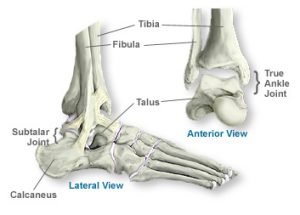Subtalar Fusion
 Surgeons utilize subtalar fusion to stabilize and reduce pain in cases of hindfoot deformity due to trauma, arthritic damage, or physiological defect. Subtalar fusion, or arthrodesis, involves fusing the heel bone, or calcaneus, to the talus bone stabilizing the heel and mid-hindfoot. The surgeon removes and fuses the subtalar joint with one or more screws inserted through the heelbone and into the talus.
Surgeons utilize subtalar fusion to stabilize and reduce pain in cases of hindfoot deformity due to trauma, arthritic damage, or physiological defect. Subtalar fusion, or arthrodesis, involves fusing the heel bone, or calcaneus, to the talus bone stabilizing the heel and mid-hindfoot. The surgeon removes and fuses the subtalar joint with one or more screws inserted through the heelbone and into the talus.
Arthritis of the Subtalar joint
Arthritis gradually destroys the cartilage in joints causing painful bone on bone rubbing that leads to bone spur formation. Arthritis most commonly occurs from natural wear and tear as we age but can also form after a fracture or from an autoimmune issue such as rheumatoid arthritis. Treating subtalar arthritis can end up leading to a subtalar fusion or to eliminate the source of instability and pain.
Trauma to the subtalar joint
Fractures involving the subtalar joint, talus or calcaneus can destabilize the hindfoot and can require an open fixation that may include subtalar fusion. Other cases that are non-operative can form post injury arthritis that may eventually require fusion to eliminate the pain and instability.
Deformity of the Subtalar joint
Some people have developmental risks acquired in their hindfeet that may be either unstable or breakdown with arthritic damage quicker leading to eventual subtalar fusion. Others may have conditions that effect the entire foot and may lead to a breakdown of the subtalar joint and the surrounding structures. A portion of their treatment may involve a subtalar fusion.
Subtalar Fusion procedure
Patients that end up needing a subtalar fusion can expect to go home the same day as the surgery. We often perform a subtalar fusion with an arthroscope on an out-patient basis, but may have to perform the case traditionally if needed. The patient undergoes anesthesia and the surgeon removes the cartilage from portions of the calcaneus and talus in the subtalar joint. The surgeon fills bone graft material into the created void and fixates the two bones together with one or more screws driven through the heelbone and into the talus.
Subtalar Fusion recovery
The patient can bear no weight for at least six weeks as the bone fusion site heals. After six weeks the patient will wear a boot or cast for another six weeks. Subtalar fusion has a high success rate and most patients return to full capacity between 6 to 12 months. Subtalar fusion has a low rate of non-union with risk factors that include patient non-compliance, diabetes, smoking, and obesity. Non-union healing results in additional surgical correction. Walking and running will feel different for the patient due to the fusion, but most patients can walk without a limp and learn to have a new normal with the slight loss of foot flexibility.

